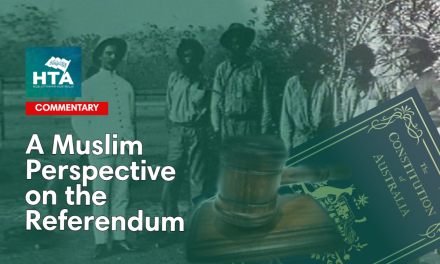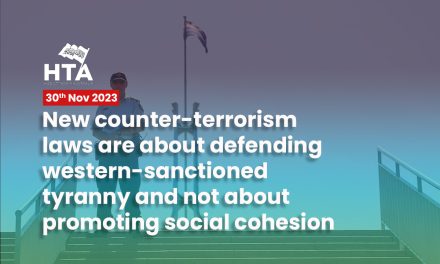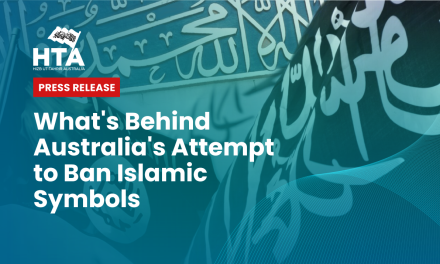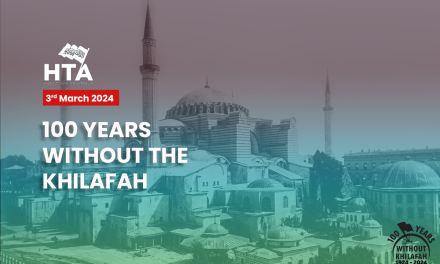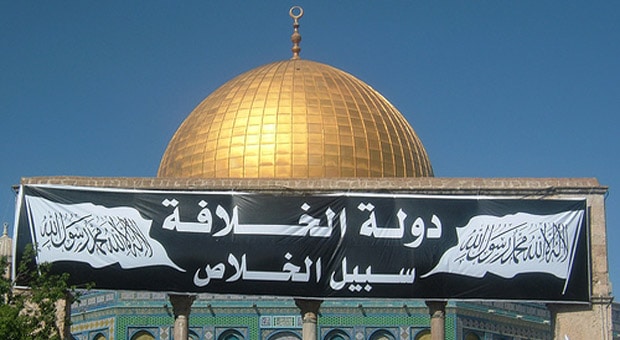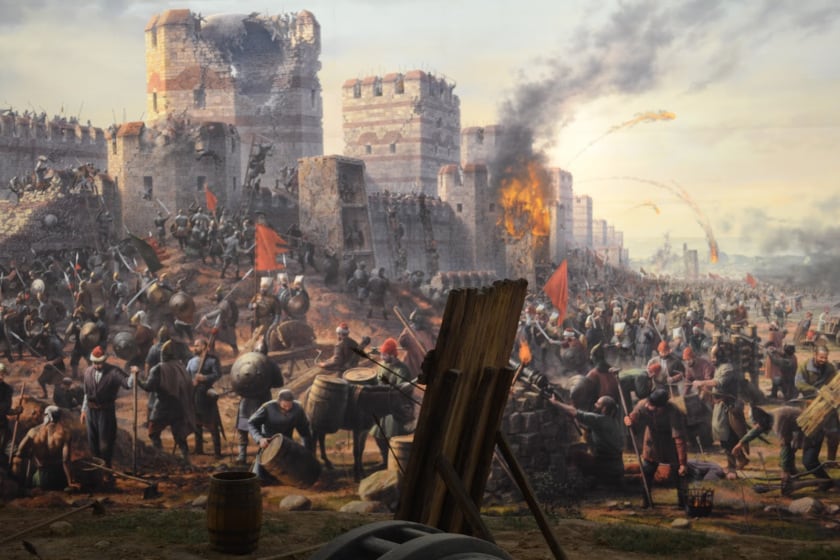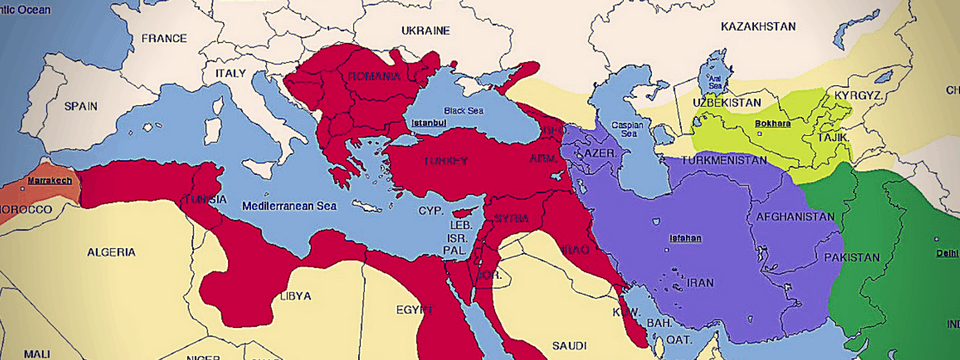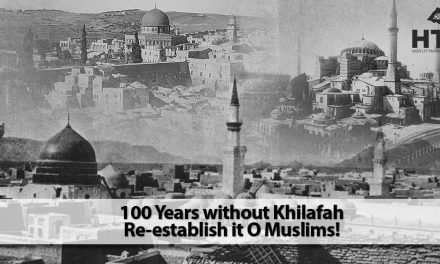In recent times, some people have made the curious argument that the Khilafah only lasted for 30 years. This article seeks to assess this claim and its basis, as well as providing some historic, textual and scholarly points in this regard, seeking to respond to the spuriousness of this claim.
This article argues that the Islamic polity Muhammad (ﷺ) established in Madinah existed until it was destroyed at the hands of Kamal Ataturk on the 3rd of March 1924. The continuity of the Islamic ruling system, embodied in the Khilafah model, beyond the time of the Khulafah Rashideen is established by historical reality and by text (divine sources; in terms of Islamic validity).
As for history, the existence or otherwise of the general structure of the Khilafah is an adequate proxy against which to judge its existence or otherwise through history. While there are differences in the details among the fuqaha as to the essential pillars of the Khilafah, some of the following elements have been posted by various authorities through time, and have also been adopted by Hizb ut-Tahrir as important elements of the Khilafah structure:
- Khaleefah (the head of government)
- Khaleefah’s delegated assistants (mu’awin Tafweed) and executive assistants (mu’awin Tanfeedh)
- Ameer of Jihad
- Governors (Wulah)
- Judges (Qudah)
- Various state departments, most importantly the Treasury (Baitul Maal)
- A form of State Assembly (Majlis al-Ummah)
If we analyse political history, we can see that all but one (Majlis al-Ummah, or Majlis al-Shura as it was also known) existed throughout the eras until the Khilafah’s destruction in 1924. The absence or neglect of the Majlis after the Khulafa Rashideen does not mean the ruling system changed because ruling is possible without shura even though it is the right of the Muslims.
As for the periods in history where no Khalifah (ruler) existed whether due to civil war or occupation by foreign armies (for instance the period of Mongol invasion), the Khilafah nonetheless as a polity still continued to exist, as did the rest of the structure.
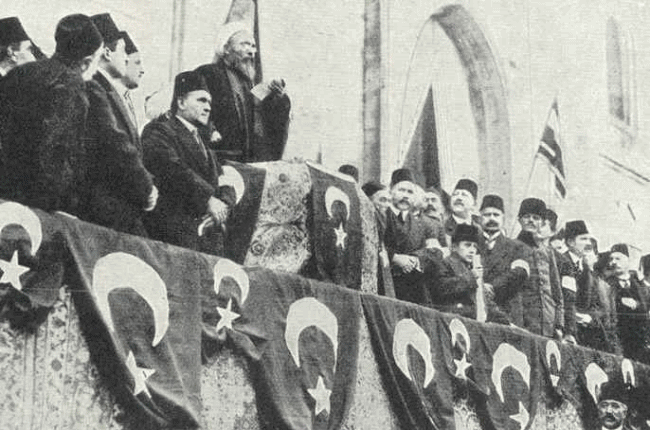
Declaration of Jihad by the Ottoman Caliphate in World War 1. The Sheikh al Islam makes a speech proclaiming the declaration.
As regards the claim of hereditary rule, it is true that the bay’ah (the process of appointing a Khaleefah) was mal-administered during certain eras, but on close inspection this too cannot be said to have affected the very validity of the Khilafah. This is because even though a Khaleefah might have taken the people’s bay’ah for his son before his death, it was always renewed afterwards. This was usually done either at the hands of the the people of influence and representation (ahl al-Halli wal- ‘aqd) or, as we saw in the later period under the Ottomans, by the Shaykh al-Islam of the Caliphate – that is, the highest Islamic authority of the land.
The scholars accepted that the Khilafah continued after the Khulafah Rashidun, although some from the Salaf disliked to use the title Khaleefah for later rulers because of the following hadith reported by Al-Tirmidhi on the authority of Safeenah who said that the Messenger (ﷺ) said:
The Khilafah in my Ummah after me will be for thirty years. Then there will be Mulkan ‘aduudan (hereditary rule) thereafter.
[Similar narrations are also to be found in the Sunan of Abu Dawud (2/264) and Musnad of Ahmad (1/169)]
According to various scholars, this hadith does not mean the Khilafah ceased to exist after thirty years because it contradicts other authentic texts.
Jabir b. Samurah (ra) narrated that the Messenger (ﷺ) said:
The Deen will continue until the Hour has been established, or you have been ruled by 12 Khulafah, all of them being from the Quraish’ [Sahih Muslim].
This hadith indicates that the Ummah will have not 4 or 5 but 12 Khulafah, indicating that the Khilafah could not have been restricted to only 30 years (which was the time at which the 4th Caliph, Ali, died).
Regarding this hadith, the great scholar Qadi ‘Iyad said:
…it has been mentioned in the latter hadith ‘The Khilafah after me will be for thirty years, then there will be a hereditary rule’; this seemingly contradicts the hadith regarding the 12 Khulafah for in the 30 years there were only the Khulafah Rashidun and months in which the bay’ah was given to al-Hasan b. al-Ali. The answer to this is: What is meant by ‘the Khilafah will be for thirty years’ is the Khilafah of the Nubuwwah (prophethood)…’ [As quoted by an-Nawawi in his Sharh Sahih Muslim, 1821]
As for the reference to 12 Khulafah, it does not mean that the Khilafah was restricted to that number as Qadi ‘Iyad further explains:
Perhaps what is meant by 12 Khulafah in these ahadith and their like is that they were the Khulafah during the strong period of the Khilafah – the power of Islam – when the affairs were in order and the people were united on those who undertook the post of Khilafah. [Tarikh al-Khulafah of as-Sayuti, p.14].
The great Shafi’i scholar Imam Ibn Hajar said in Sharh of Al-Bukhari:
What Qadi ‘Iyad said is the best of what has been said regarding the hadith; I think it is the strongest opinion because it is supported by sayings of the Prophet through authentic lines of transmission such as: ‘And people will gather round all of them…’ [Fath al-Baari]
and then Imam Ibn Hajar gives a historical account of how people had gathered around and united under certain Khulafah after the Khulafah Rashidun; he mentions the likes of ‘Umar ibn Abdul Aziz and he even mentions “khulafa bani Abbas” i.e. amongst the Abbasids.
Imam Sayf ad-Deen al-Aamidi, the great Shafi’i scholar and Usuli, said in his book al-Imaamah min abkar al-afkar fi usul ad-din (p.306):
And his (ﷺ) saying ‘After me the Khilafah will be for 30 years and then it will turn into a mulkan adooda (hereditary kingship)’ this hadith does not indicate that the Khilafah is restricted to the Khulafah Rashideen since their Khilafah lasted for 30 years as stated by the Prophet (ﷺ). And nor does the hadith mean that there is no Khilafah after the Khulafah Rashideen. Rather what is meant is: The Khilafah after me in terms of the responsibilities of the Imamah and following my Sunnah without increase or neglect will be for 30 years, contrary to the period after this. Despite this the continuity of the Khilafah is indicated by the following two things:
The first: The Ijma’ of the Ummah in every age on the obligation to follow an Imam of that time and upon the fact that the Imam and Khaleefah must be obeyed.
Second: He (ﷺ) said: ‘then it will become (taseer) a mulkan’. The personal pronoun (dameer) in ‘taseeru milkan’ refers to the Khilafah. Since the mentioned (verb) cannot refer to anything other than the Khilafah, as if it is saying ‘and then the Khilafah becomes a mulk’. From this it is judged that the Khilafah will become a mulk; the judgment on a thing requires that the thing itself exists.
In the first point Imaam Amidi explains that the Ummah is agreed, and this of course is due to textual evidence, that the Imaam (Khalifah) of that age must be followed and hence one cannot argue the hadith is restricting any Khilafah after it. And his second argument is linguistic: the hadith is saying an aspect of the Khilafah will change and not the Khilafah itself.
It is like saying ‘and then Tariq became angry’; the transforming of Tariq to a state of anger does not mean Tariq has become Ali or ‘Umar. He is still Tariq but an aspect of his state has changed which is that he has become angry. Similarly, when the hadith says ‘thumma taseeru mulkan’ (and then it will become a hereditary rule) it does not mean that it ceases to be a Khilafah.
In fact in one of the narrations of the above hadith says: ‘The Khilafah of the Prophethood will be 30 years and then it will become a kingship,’ In other words what will cease is the (perfect) Khilafah of Prophethood and not the Khilafah itself.
Imaam at-Taftazani, referring to the fact that the rulers after Imam ‘Ali were considered kings by some:
This is a difficult problem, for the people of influence and representation (ahl halli wal ‘aqd) of the Muslim people were agreed on the Khilafah of the Abbasids and some of Banu Marwan, such as ‘Umar b. ‘Abd al-Aziz, for example. Perhaps the meaning here (referring to the above hadith that the Khilafah will be 30 years) is rather that the perfect Khilafah, in which there is no dross due to difference or inclination away from following [the right way], will be for a period of 30 years…
…If objection is made that since the period of the Khilafah was 30 years, then the time subsequent to the rightly guided Khalifahs is devoid of the Imam and whole of the Muslim people are thus disobedient when they die because they die as in the days of ignorance (as per the famous hadith) we reply that it has already been pointed out that the perfect Khilafah is what is meant.
It is well known from one of the famous ahadith that to die without a Khaleefah is to die the death of Jahiliyyah; hence, Imam At-Taftazani replies by saying the Muslims in those days were not sinful because the Khilafah did exist as the hadith only refers to the perfect Khilafah of the Rashidun era.
Imam Jalal al-Din al-Suyuti (b.911 AH) in his Tarikh al-Khulafah (History of the Caliphs) recounts history of the Khulafah until his time with the death Khalifah Mutawakkil Abul ‘Izz in 903 AH and the appointment of his son al-Mustamsik Billah.
He says in his introduction to the Tarikh:
This is a brief history in which I present the biography of the Khulafah, the Amirs of the Believers who looked after the affaires of the Ummah from the time of Abu Bakr as-Siddeeq – may Allah be pleased with him! – until this our time…’
and that was (only) 900 years after the Hijrah!
The notable scholars throughout the ages had a relationship with the Khulafah, whether they accounted them, such as Imam Abu Hanifah and al-Mansur, or they worked for them (such as Qadi Abu Yusuf who was the Qadi al-Qudah (chief judge) under Harun ar-Rashid) or they participated in the bay’ah of a Khaleefah such as Imam ‘Izz b. Abd as-Salam, who gave bay’ah to Mustansir Billah after the defeat of the Tatars.
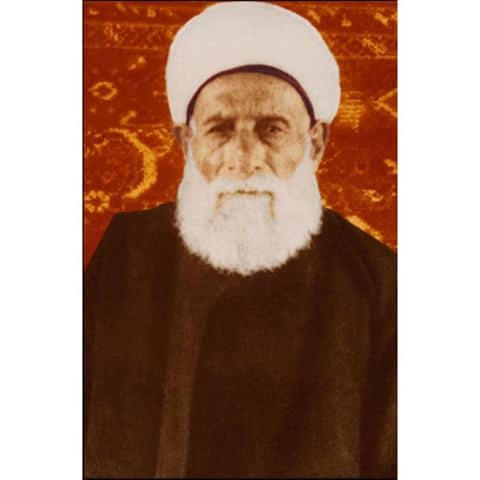
Qadi Yusuf Nabhani, a great scholar of the late 19th and early 20th century, who was a Judge under the Ottoman Caliphate and wrote extensively on the obligation of the Caliphate
Towards the end of the Ottoman Caliphate when the big powers were conspiring against it, Sheikh ul-Hind Maulana Mahmood Hassan (who was the then head of Darul Uloom Deoband and direct student of Maulana Qasim Nanautavi, the founding father of the Darul ‘Uloom) in the 1920’s mentioned a fatwa regarding saving the Ottoman Caliphate from the enemies of Islam.
The respected Maulana said:
The enemies of Islam have left no stone unturned to strike against and harm the honour and prestige of Islam. Iraq, Palestine and Syria that were won over by the Prophet’s companions and his followers, after in numerous sacrifices, have once again become targets of greed of the enemy of Islam. The honor of Khilafat is in tatters. Khalifatul-Muslimin, who used to unite the entire community on this planet; who is the vice-regent of Allah on this earth; used to implement the universal law of Islam; who used to protect the rights and interests of Muslims and used to preserve and ensure the glory of the words of the Creator of this universe be preserved and implemented, has been surrounded by enemies and made redundant.’ [From the Fatwa of Sheikh ul Hind Maulana Mahmood Hassan, 16th Safar 1339 AH, October 29 1920 CE, page 78 of English translation of ‘The Prisoners of Malta’ by Maulana Syed Mohammad Mian, published by Jamiat Ulama-I-Hind]
The continuity of the obligation of Khilafah after the Khulafah Rashideen is a pillar of Ahl as-Sunnah and hence at-Taftazaani (who incidentally was a Shafi’i scholar) in his commentary (sharh) of the Aqeedah of Imam an-Nasafi (who was a Hanafi) said:
The position of agreement is that it is obligatory to appoint an Imam. The difference of opinion is on the question whether the appointment must be by Allah or by His creatures, and whether the basis [for appointment] is text or reason. The correct position is that the creatures must appoint a Khaleefah because of the statement of the Prophet (ﷺ): ‘Whosoever dies without knowing the Imam of his time, dies the death of Jahiliyyah.’
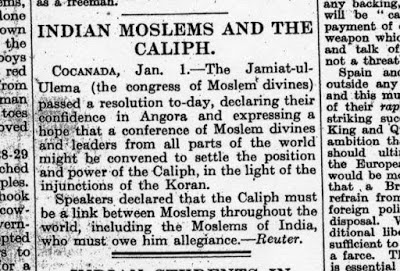
A remarkable newspaper clipping from the early 20th century showing the concern of Muslim scholars from India regarding the continuity of the Ottoman Caliphate, which they regarded as the legitimate Islamic rule. Jamia-Ulema-Hind was a peak scholarly body of ‘ulema from India.
Imam At-Taftazani also says:
The Muslims must have an Imaam, who will carry out the administration of their decisions, the maintaining of their restrictive ordinances, the guarding of their frontiers, the equipping of their armies, the receiving of their alms, the subjugation of those who get the upper hand and robbers and highwaymen, the performance of worship on Fridays and the Festivals, the settlement of disputes which take place amongst creatures, the receiving of evidence based on legal rights, the giving in marriage of young men and maidens who have no guardians, and the division of the booty and things like these which individuals of the people are not entrusted.’ [Sharh ‘Aqidat an-Nasafiyyah, p.147]
What Imaam at-Taftazani says is considered the last word on what Ahl as-Sunnah agreed and the above quote on the obligation of appointing a Khaleefah is clear regardless of ones historical interpretation. It is inconceivable that there not have been a valid Khilafah after 30 years post-Hijrah and centuries of esteemed Islamic scholarship have held otherwise; it is also inconceivable that some of the greatest scholars, known for their piety and erudition, would have stood idly by and said nothing on a matter so grave had it indeed been the case.
The argument that the Khilafah lasted only 30 years mis-interprets one hadith, ignoring many others in the process, and is a largely modern argument, spurred on by some who seek to discredit centuries of valid Islamic rule in favour of their own partisan, modern political positions.
All praise belongs to Allah, and salutations to his Prophet Muhammad ﷺ, his family, companions, and the great Khulafah who ruled for Allah’s sake after him.
![]()


